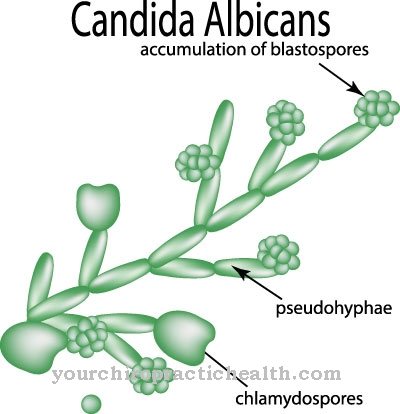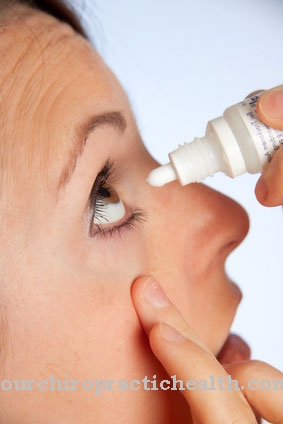Fleas or a Flea bite usually occur with very severe itching. Small pustules can be seen on the affected areas, often a large number of them. The bites of these parasites are not dangerous at our level, but extremely unpleasant. You can protect yourself against it by taking appropriate measures.
What is a flea bite?
.jpg)
© savelov - stock.adobe.com
A flea infestation is usually very easy to recognize: there are many small pustules on the skin, which often cause severe itching.
These pustules are light red, slightly raised and about one centimeter in size. The individual reddening of the skin usually occurs in groups or even in a row. To avoid secondary infection, the affected areas of the skin should not be scratched. Otherwise pathogens can penetrate the skin and cause inflammation.
The fleas can belong to different genera. While the human flea occurs very rarely with us, it is more often the cat flea or dog flea, which also bites people. There are also other types of fleas, such as hedgehog or chicken fleas.
causes
The cause of fleas can be different. While the human flea is mainly around humans, in our region it is mostly a "stray" flea if a person has received flea bites. Very often it is the cat flea. We can encounter it anywhere: outdoors, in public facilities or our own pet has brought the parasites into the house.
The blood of mammals is vital for fleas; it is their only food. A flea therefore usually takes its blood meal once a day. However, an adult flea can go without food for up to 2 months. Therefore, “starving” fleas control is not a really good method.
Incidentally, nothing can be felt during the flea bite, because the flea secretes an analgesic secretion with the bite. The itching doesn't start until the flea has finished eating.
Symptoms, ailments & signs
Flea bites can be recognized primarily by the reddish discoloration of the skin. The bites are very itchy and cause papules or swelling on the skin. The actual flea bite has a reddish color that increases towards the middle. Usually two or more bites occur at the same time, which creates the characteristic appearance of the flea bites.
After 12 to 24 hours, skin blisters or purulent pustules that are associated with severe itching develop in the area around the bite. As it progresses, the redness decreases and the bites take on an almost skin-colored appearance. If there is no treatment, there are usually more flea bites, often on different parts of the body. Flea bites are most common on the legs and especially on the feet.
Fleas also nestle in the hips, knees, elbows and armpits. The symptoms mentioned usually persist for one to two weeks and then subside with appropriate treatment. If the bites are scratched open, a wound infection can develop. An infection manifests itself as increasing itching, redness and in some cases bleeding. It can also leave scars.
Diagnosis & course
Diagnosing fleas is quite easy. The animal's droppings are best identifiable: since fleas like it warm and dark, they usually stay in the fur or hair. The fur should be combed out over white paper.
The combed-out parts are then moistened. If black crumbs turn red in the process, it is flea excrement and an infestation is relatively certain. This color test works because fleas excrete the blood pigment from the meals they eat. Dried blood is black and can be recognized as blood again after moistening.
The diagnosis can also be made based on the skin changes. The less the pustules have been scratched, the better the identification can take place.
If you suspect fleas in your pet, you should visit the vet. If there are no pets and there is still a strong suspicion of a flea infestation and not just a stray flea, the family doctor can help. In either case, targeted treatments and methods can eliminate the flea infestation and associated symptoms.
Complications
At first glance, a flea bite is not a worrying event. However, this can also lead to various complications. The bite itself will absolutely not hurt the affected person. However, an allergic reaction can then occur.
As a rule, severe itching occurs just a few minutes after the bite, which is also visually noticeable as a reddened point. Repeated itching can cause the bite to become infected. It is not uncommon for an open wound to develop that should be protected from bacteria and other contaminants.
Otherwise an infection can occur very quickly, so that pus can even form. Such a complication should definitely be treated by a doctor. However, with the right medication, inflammation can be treated very quickly and effectively. Of course, the extent to which the bites occur also plays a role.
If there is an extremely strong flea infestation, other people can also be affected by the above-mentioned complications. Before taking any action against the bites, the first thing to do is to get rid of the fleas. There is absolutely no need to worry or worry about communicable diseases within the Federal Republic of Germany.
When should you go to the doctor?
If itchy, red spots are noticed on the skin, it is likely a flea bite. A doctor should be consulted if the noticeable areas of skin have not disappeared after a week at the latest. If swelling or bleeding occurs in the skin, the person concerned must seek medical advice on the same day.
If fleas are detected early, they can be treated quickly and effectively. If the insect infestation remains untreated, serious complications can arise. Infection is such a complication and must be treated promptly.
At the latest when other family members or work colleagues show signs of a flea infestation, a visit to the family doctor is indicated. Children, the elderly, allergy sufferers and pregnant women should consult a specialist immediately if they have symptoms of a flea infestation.
If painful, white pustules form on the skin, this indicates an allergic reaction or advanced infection. A doctor must examine the skin and prescribe an appropriate medication. A few days after treatment, the person should be re-examined for fleas.
Doctors & therapists in your area
Treatment & Therapy
Treatment for a flea bite includes both symptoms and addressing the cause. In any case, mechanical effects from scratching should be avoided as far as possible. This not only further irritates the skin, it can also cause scars and, in the worst case, severe inflammation because pathogens have penetrated the open areas.
The therapy of the symptoms depends on the existing extent. If the skin is already very inflamed from excessive scratching, ointments containing antibiotics can be used. If the person concerned is allergic to the flea bites, cortisone provides good relief from the symptoms. Cooling creams or skin compresses are sufficient to just soothe the bare itching of the pustules. A flea bite usually heals completely within 2 weeks.
If the cause of fleas is in a pet, the animal must be treated accordingly. Veterinarians have a variety of preparations that are effective at fighting fleas. Often come here like this. Spot ons for use or medicinal powders that are worked into the fur and thus fight the fleas.
But the environment must not be neglected either. Dog blankets and other textiles that the fleas may have come into contact with should be washed at the highest possible temperature. Thorough vacuuming of the entire living area is also advisable.
Outlook & forecast
Thanks to the good medical care and the social changes of the last century, the infestation by fleas is not a big problem nowadays. Normally, the patient is considered symptom-free within 1-2 weeks when receiving medical treatment. Since there are numerous species of fleas and they can occur in all public and private locations, the micro-animals spread rapidly.
The spread can be stopped quickly with adequate hygienic measures, drug treatment and targeted precautionary measures. A doctor is not needed for some sufferers and a very small number of flea bites. Often humans are only an intermediate host and the flea has already moved independently to another host within a few hours. In addition, flea bites usually heal completely after a short time.
If there are open wounds, the healing process can be delayed. In some cases pathogens enter the organism through the wounds and cause complications. In addition to the outbreak of other diseases, there is a risk of blood poisoning.
If there is no early medical care, the patient is threatened with death if the disease progresses. If the flea infestation leads to mental disorders, complications can also arise.In addition to anxiety, panic attacks are possible consequences that contribute to a deterioration in well-being.
prevention
A prevention against fleas is not 100% possible. Since flea bites can occur anywhere, real protection is not possible. However, pet owners should regularly check whether their pet has become infected with fleas. Many tick remedies that are used anyway also prevent flea infestation. Despite these measures, flea bites can still occur.
Aftercare
The disease usually proceeds without complications. There are no more complaints within two weeks. Rather, it is important to prevent the fleas from recurring. This is most effectively done through preventive measures that are the responsibility of the patient.
Since pets are often transmitted, they should be checked regularly. Hygiene measures must be integrated into everyday life. Dust should be wiped more and the floors kept clean. Prevention aims to identify and eliminate sources of origin. Sometimes the infection of the sleeping area cannot contain the flea infestation.
By the way, patients do not build up immunity to the flea bite. Infection is always possible. A flea infestation is associated with skin changes. These can usually be seen with the naked eye. In addition, the typical symptoms, such as itching, support a diagnosis.
Therapy is based on the intensity of the symptoms even if it occurs again. Advanced disease requires longer treatment. If there is inflammation, ointments containing antibiotics provide relief. If an illness is connected with an allergic reaction, cortisone promises a cure.
You can do that yourself
If there is an existing flea infestation, those affected can do a few things themselves to remedy the causes and symptoms. First, the area should be checked for possible flea infestation. Often, pets bring the fleas into the human environment. If the pets are free of fleas or if they are being treated, all textiles should also be washed at the highest possible temperature. You must also clean your own clothing, hand towels and bed linen.
To counteract the symptoms, itch-relieving ointments or gel can be applied. Aloe vera juice is available as a gel in pharmacies and cools naturally. Coconut oil is just as gentle as a skin care product. The oil also has a disinfecting property. The mechanical irritation of the skin through frequent scratching represents a risk of infection and should therefore be avoided.
Antiseptic ointments are used if the skin is already damaged and there is an infectious inflammation. Antibiotic treatment cannot be ruled out in this context. Cortisone treatment also helps some patients.
Special hygiene measures must also be observed. The rooms should be vacuumed more frequently and more dust should be removed from surfaces. A subsequent cleaning of the surfaces with a mixture of water and citronella oil drives away the vermin. Fleas also don't like geranium oil and vinegar.




.jpg)
.jpg)



















.jpg)


